Christopher Morris
Generalizable Insights for Graph Transformers in Theory and Practice
Nov 11, 2025Abstract:Graph Transformers (GTs) have shown strong empirical performance, yet current architectures vary widely in their use of attention mechanisms, positional embeddings (PEs), and expressivity. Existing expressivity results are often tied to specific design choices and lack comprehensive empirical validation on large-scale data. This leaves a gap between theory and practice, preventing generalizable insights that exceed particular application domains. Here, we propose the Generalized-Distance Transformer (GDT), a GT architecture using standard attention that incorporates many advancements for GTs from recent years, and develop a fine-grained understanding of the GDT's representation power in terms of attention and PEs. Through extensive experiments, we identify design choices that consistently perform well across various applications, tasks, and model scales, demonstrating strong performance in a few-shot transfer setting without fine-tuning. Our evaluation covers over eight million graphs with roughly 270M tokens across diverse domains, including image-based object detection, molecular property prediction, code summarization, and out-of-distribution algorithmic reasoning. We distill our theoretical and practical findings into several generalizable insights about effective GT design, training, and inference.
Understanding Generalization in Node and Link Prediction
Jul 01, 2025Abstract:Using message-passing graph neural networks (MPNNs) for node and link prediction is crucial in various scientific and industrial domains, which has led to the development of diverse MPNN architectures. Besides working well in practical settings, their ability to generalize beyond the training set remains poorly understood. While some studies have explored MPNNs' generalization in graph-level prediction tasks, much less attention has been given to node- and link-level predictions. Existing works often rely on unrealistic i.i.d.\@ assumptions, overlooking possible correlations between nodes or links, and assuming fixed aggregation and impractical loss functions while neglecting the influence of graph structure. In this work, we introduce a unified framework to analyze the generalization properties of MPNNs in inductive and transductive node and link prediction settings, incorporating diverse architectural parameters and loss functions and quantifying the influence of graph structure. Additionally, our proposed generalization framework can be applied beyond graphs to any classification task under the inductive or transductive setting. Our empirical study supports our theoretical insights, deepening our understanding of MPNNs' generalization capabilities in these tasks.
Survey on Generalization Theory for Graph Neural Networks
Mar 19, 2025Abstract:Message-passing graph neural networks (MPNNs) have emerged as the leading approach for machine learning on graphs, attracting significant attention in recent years. While a large set of works explored the expressivity of MPNNs, i.e., their ability to separate graphs and approximate functions over them, comparatively less attention has been directed toward investigating their generalization abilities, i.e., making meaningful predictions beyond the training data. Here, we systematically review the existing literature on the generalization abilities of MPNNs. We analyze the strengths and limitations of various studies in these domains, providing insights into their methodologies and findings. Furthermore, we identify potential avenues for future research, aiming to deepen our understanding of the generalization abilities of MPNNs.
Position: Graph Learning Will Lose Relevance Due To Poor Benchmarks
Feb 20, 2025
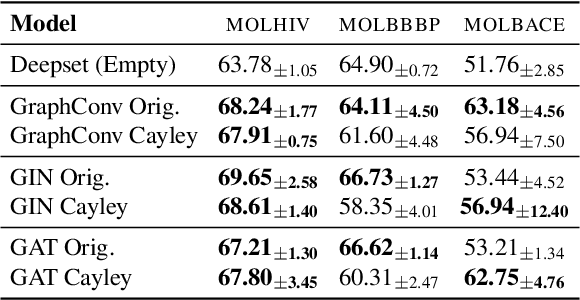
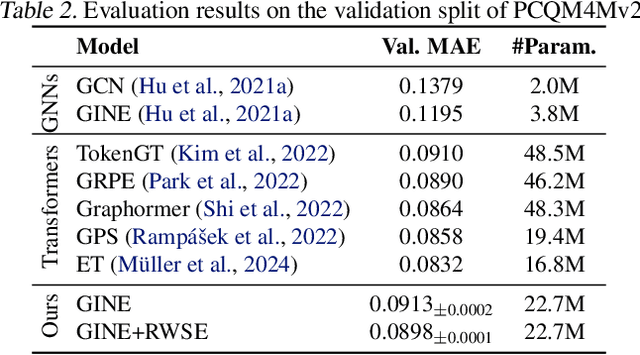

Abstract:While machine learning on graphs has demonstrated promise in drug design and molecular property prediction, significant benchmarking challenges hinder its further progress and relevance. Current benchmarking practices often lack focus on transformative, real-world applications, favoring narrow domains like two-dimensional molecular graphs over broader, impactful areas such as combinatorial optimization, relational databases, or chip design. Additionally, many benchmark datasets poorly represent the underlying data, leading to inadequate abstractions and misaligned use cases. Fragmented evaluations and an excessive focus on accuracy further exacerbate these issues, incentivizing overfitting rather than fostering generalizable insights. These limitations have prevented the development of truly useful graph foundation models. This position paper calls for a paradigm shift toward more meaningful benchmarks, rigorous evaluation protocols, and stronger collaboration with domain experts to drive impactful and reliable advances in graph learning research, unlocking the potential of graph learning.
Towards graph neural networks for provably solving convex optimization problems
Feb 04, 2025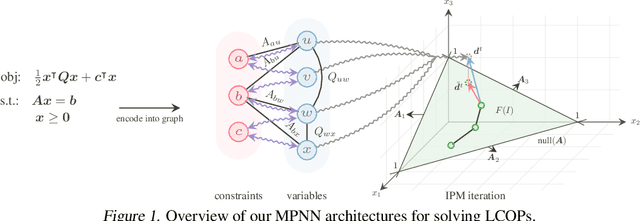
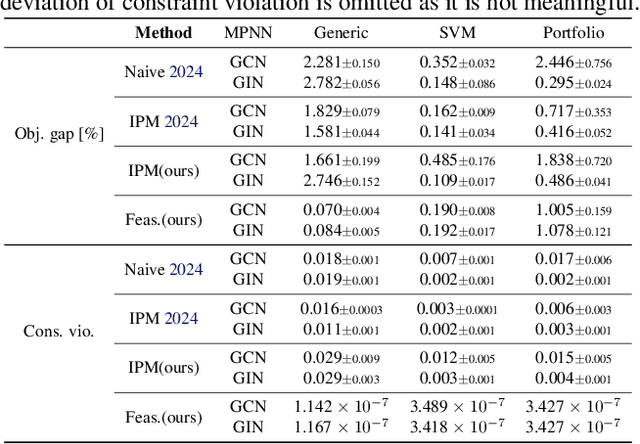
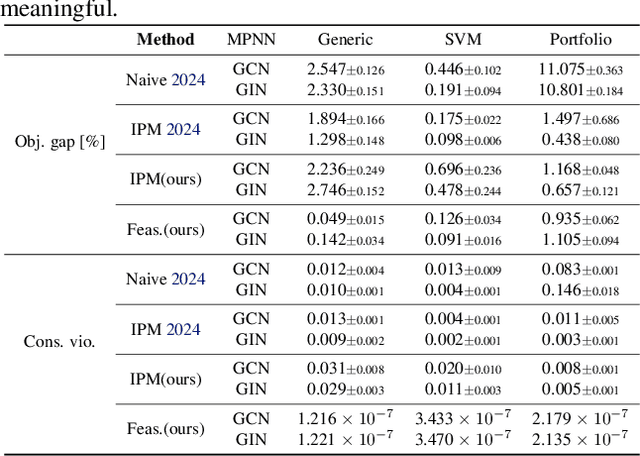
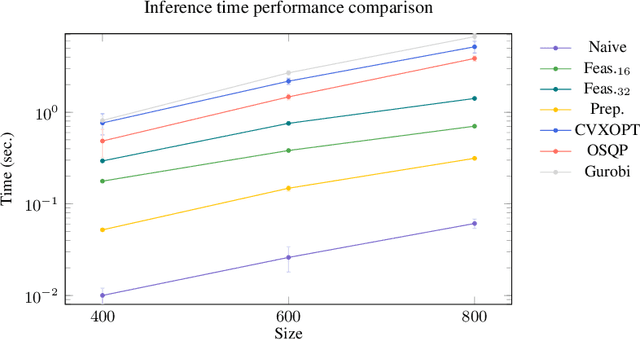
Abstract:Recently, message-passing graph neural networks (MPNNs) have shown potential for solving combinatorial and continuous optimization problems due to their ability to capture variable-constraint interactions. While existing approaches leverage MPNNs to approximate solutions or warm-start traditional solvers, they often lack guarantees for feasibility, particularly in convex optimization settings. Here, we propose an iterative MPNN framework to solve convex optimization problems with provable feasibility guarantees. First, we demonstrate that MPNNs can provably simulate standard interior-point methods for solving quadratic problems with linear constraints, covering relevant problems such as SVMs. Secondly, to ensure feasibility, we introduce a variant that starts from a feasible point and iteratively restricts the search within the feasible region. Experimental results show that our approach outperforms existing neural baselines in solution quality and feasibility, generalizes well to unseen problem sizes, and, in some cases, achieves faster solution times than state-of-the-art solvers such as Gurobi.
Covered Forest: Fine-grained generalization analysis of graph neural networks
Dec 10, 2024Abstract:The expressive power of message-passing graph neural networks (MPNNs) is reasonably well understood, primarily through combinatorial techniques from graph isomorphism testing. However, MPNNs' generalization abilities -- making meaningful predictions beyond the training set -- remain less explored. Current generalization analyses often overlook graph structure, limit the focus to specific aggregation functions, and assume the impractical, hard-to-optimize $0$-$1$ loss function. Here, we extend recent advances in graph similarity theory to assess the influence of graph structure, aggregation, and loss functions on MPNNs' generalization abilities. Our empirical study supports our theoretical insights, improving our understanding of MPNNs' generalization properties.
Cometh: A continuous-time discrete-state graph diffusion model
Jun 10, 2024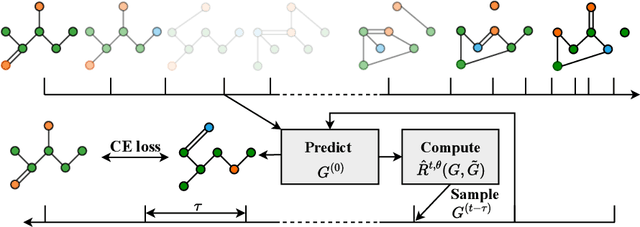
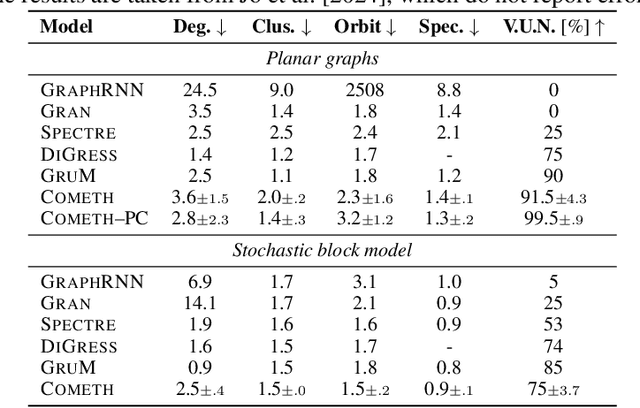

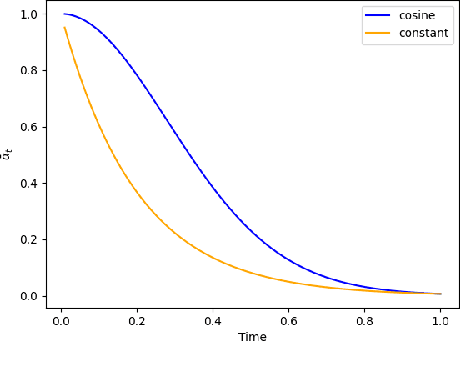
Abstract:Discrete-state denoising diffusion models led to state-of-the-art performance in graph generation, especially in the molecular domain. Recently, they have been transposed to continuous time, allowing more flexibility in the reverse process and a better trade-off between sampling efficiency and quality. Here, to leverage the benefits of both approaches, we propose Cometh, a continuous-time discrete-state graph diffusion model, integrating graph data into a continuous-time diffusion model framework. Empirically, we show that integrating continuous time leads to significant improvements across various metrics over state-of-the-art discrete-state diffusion models on a large set of molecular and non-molecular benchmark datasets.
Aligning Transformers with Weisfeiler-Leman
Jun 05, 2024



Abstract:Graph neural network architectures aligned with the $k$-dimensional Weisfeiler--Leman ($k$-WL) hierarchy offer theoretically well-understood expressive power. However, these architectures often fail to deliver state-of-the-art predictive performance on real-world graphs, limiting their practical utility. While recent works aligning graph transformer architectures with the $k$-WL hierarchy have shown promising empirical results, employing transformers for higher orders of $k$ remains challenging due to a prohibitive runtime and memory complexity of self-attention as well as impractical architectural assumptions, such as an infeasible number of attention heads. Here, we advance the alignment of transformers with the $k$-WL hierarchy, showing stronger expressivity results for each $k$, making them more feasible in practice. In addition, we develop a theoretical framework that allows the study of established positional encodings such as Laplacian PEs and SPE. We evaluate our transformers on the large-scale PCQM4Mv2 dataset, showing competitive predictive performance with the state-of-the-art and demonstrating strong downstream performance when fine-tuning them on small-scale molecular datasets. Our code is available at https://github.com/luis-mueller/wl-transformers.
Probabilistic Graph Rewiring via Virtual Nodes
May 27, 2024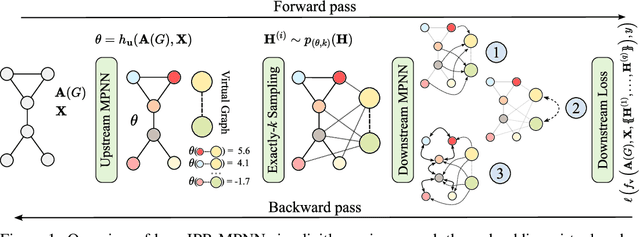



Abstract:Message-passing graph neural networks (MPNNs) have emerged as a powerful paradigm for graph-based machine learning. Despite their effectiveness, MPNNs face challenges such as under-reaching and over-squashing, where limited receptive fields and structural bottlenecks hinder information flow in the graph. While graph transformers hold promise in addressing these issues, their scalability is limited due to quadratic complexity regarding the number of nodes, rendering them impractical for larger graphs. Here, we propose \emph{implicitly rewired message-passing neural networks} (IPR-MPNNs), a novel approach that integrates \emph{implicit} probabilistic graph rewiring into MPNNs. By introducing a small number of virtual nodes, i.e., adding additional nodes to a given graph and connecting them to existing nodes, in a differentiable, end-to-end manner, IPR-MPNNs enable long-distance message propagation, circumventing quadratic complexity. Theoretically, we demonstrate that IPR-MPNNs surpass the expressiveness of traditional MPNNs. Empirically, we validate our approach by showcasing its ability to mitigate under-reaching and over-squashing effects, achieving state-of-the-art performance across multiple graph datasets. Notably, IPR-MPNNs outperform graph transformers while maintaining significantly faster computational efficiency.
Weisfeiler-Leman at the margin: When more expressivity matters
Feb 12, 2024



Abstract:The Weisfeiler-Leman algorithm ($1$-WL) is a well-studied heuristic for the graph isomorphism problem. Recently, the algorithm has played a prominent role in understanding the expressive power of message-passing graph neural networks (MPNNs) and being effective as a graph kernel. Despite its success, $1$-WL faces challenges in distinguishing non-isomorphic graphs, leading to the development of more expressive MPNN and kernel architectures. However, the relationship between enhanced expressivity and improved generalization performance remains unclear. Here, we show that an architecture's expressivity offers limited insights into its generalization performance when viewed through graph isomorphism. Moreover, we focus on augmenting $1$-WL and MPNNs with subgraph information and employ classical margin theory to investigate the conditions under which an architecture's increased expressivity aligns with improved generalization performance. In addition, we show that gradient flow pushes the MPNN's weights toward the maximum margin solution. Further, we introduce variations of expressive $1$-WL-based kernel and MPNN architectures with provable generalization properties. Our empirical study confirms the validity of our theoretical findings.
 Add to Chrome
Add to Chrome Add to Firefox
Add to Firefox Add to Edge
Add to Edge